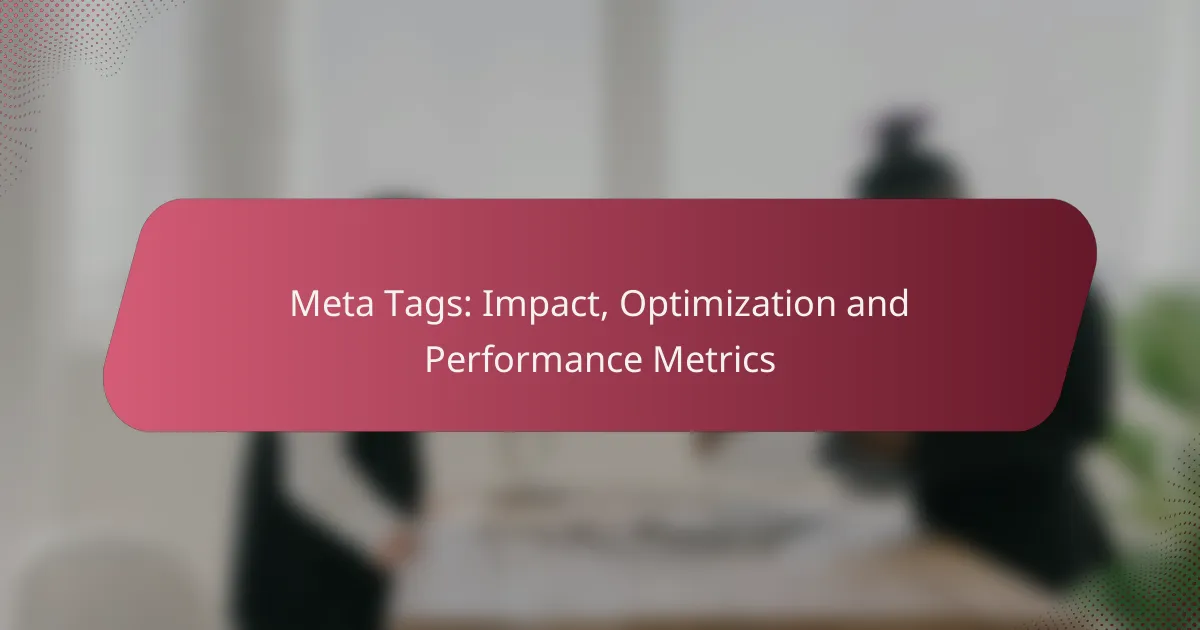Meta tags are vital for enhancing SEO performance, as they provide search engines with key information about a webpage’s content. By optimizing these tags with relevant keywords and compelling descriptions, websites can improve their visibility and click-through rates, particularly in competitive markets. Understanding and effectively utilizing meta tags can significantly impact a site’s overall performance in search results.
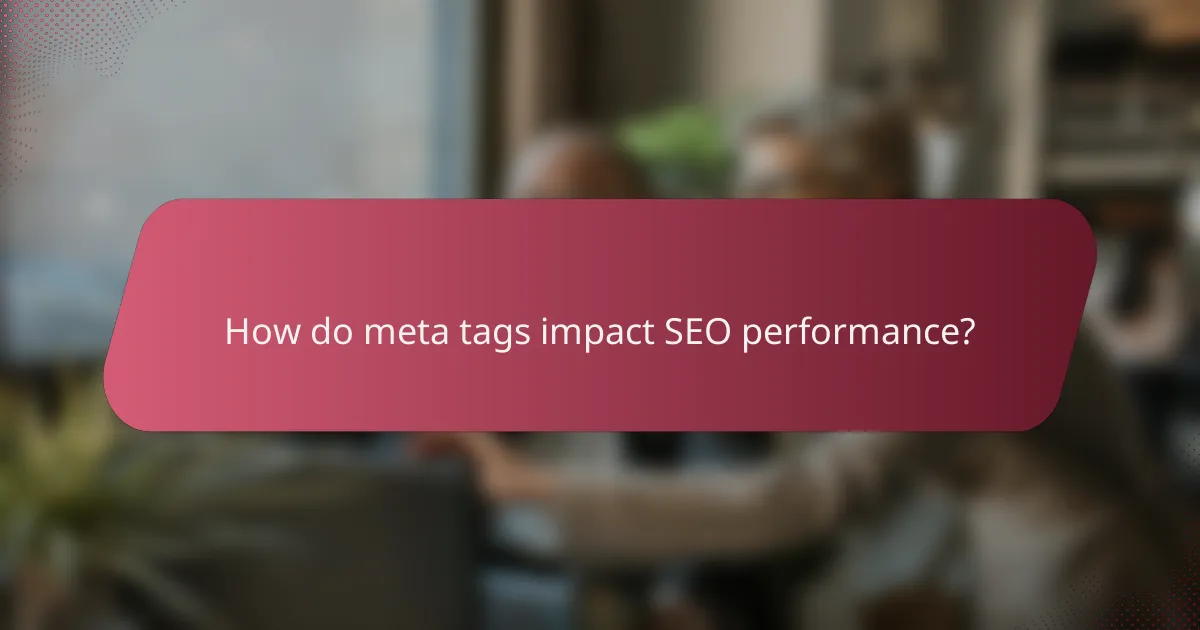
How do meta tags impact SEO performance?
Meta tags significantly influence SEO performance by providing search engines with essential information about a webpage. They help in defining how content is indexed and displayed in search results, ultimately affecting visibility and user engagement.
Increased click-through rates
Meta tags, particularly title tags and meta descriptions, play a crucial role in attracting clicks from search engine results pages (SERPs). A compelling title and description can lead to higher click-through rates (CTR), as they serve as the first impression for users. Aim for concise, engaging language that includes relevant keywords to capture attention.
For example, a well-crafted meta description can summarize the content effectively, enticing users to click. Testing different variations can help identify which phrases yield the best results.
Improved search engine rankings
While meta tags alone do not guarantee higher rankings, they contribute to SEO by enhancing relevance signals to search engines. Properly optimized title tags and descriptions can improve a page’s visibility, making it more likely to rank higher for targeted keywords. Focus on including primary keywords early in the title for better impact.
Regularly reviewing and updating meta tags in response to changing trends and user behavior can help maintain or improve rankings over time.
Enhanced user experience
Meta tags enhance user experience by providing clear and relevant information about the webpage’s content. When users find accurate descriptions that match their search intent, they are more likely to engage with the content. This alignment can lead to lower bounce rates and longer session durations.
To optimize user experience, ensure that meta tags accurately reflect the content and avoid misleading descriptions. Consistency between meta tags and on-page content fosters trust and encourages users to explore further.
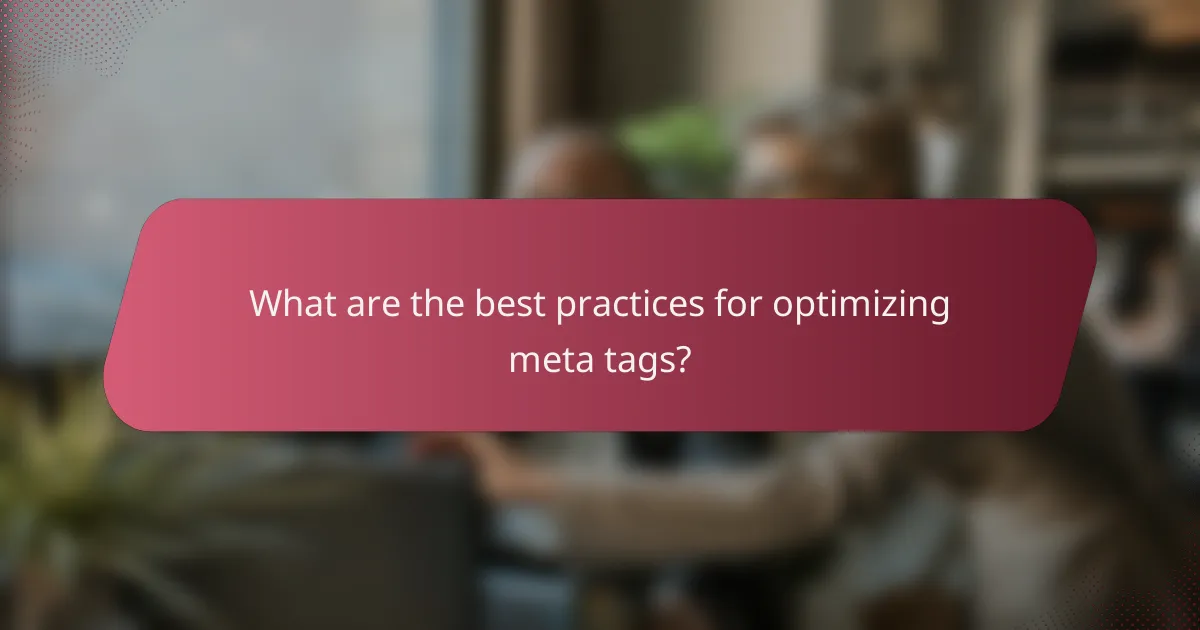
What are the best practices for optimizing meta tags?
Optimizing meta tags involves using relevant keywords, adhering to character limits, and crafting compelling descriptions. These practices enhance search engine visibility and improve click-through rates, making them essential for effective web content.
Use relevant keywords
Incorporating relevant keywords into your meta tags is crucial for search engine optimization (SEO). Focus on terms that accurately reflect the content of your page and align with what users are searching for. Tools like Google Keyword Planner can help identify popular keywords in your niche.
Aim to include primary keywords in the title and description tags, as these elements significantly influence search rankings. However, avoid keyword stuffing, which can lead to penalties from search engines.
Keep within character limits
Character limits for meta tags are important to ensure that your content displays correctly in search results. Typically, title tags should be around 50-60 characters, while meta descriptions should be between 150-160 characters. Exceeding these limits may result in truncation, which can obscure your message.
To maximize impact, prioritize the most important information at the beginning of your tags. This way, even if the text is cut off, the key points remain visible to users.
Write compelling descriptions
A compelling meta description can significantly increase the likelihood of users clicking on your link. Focus on creating concise, engaging summaries that highlight the value of your content. Use action-oriented language and include a call to action when appropriate.
Consider testing different descriptions to see which ones yield higher click-through rates. Regularly updating your meta descriptions based on performance metrics can help maintain their effectiveness over time.
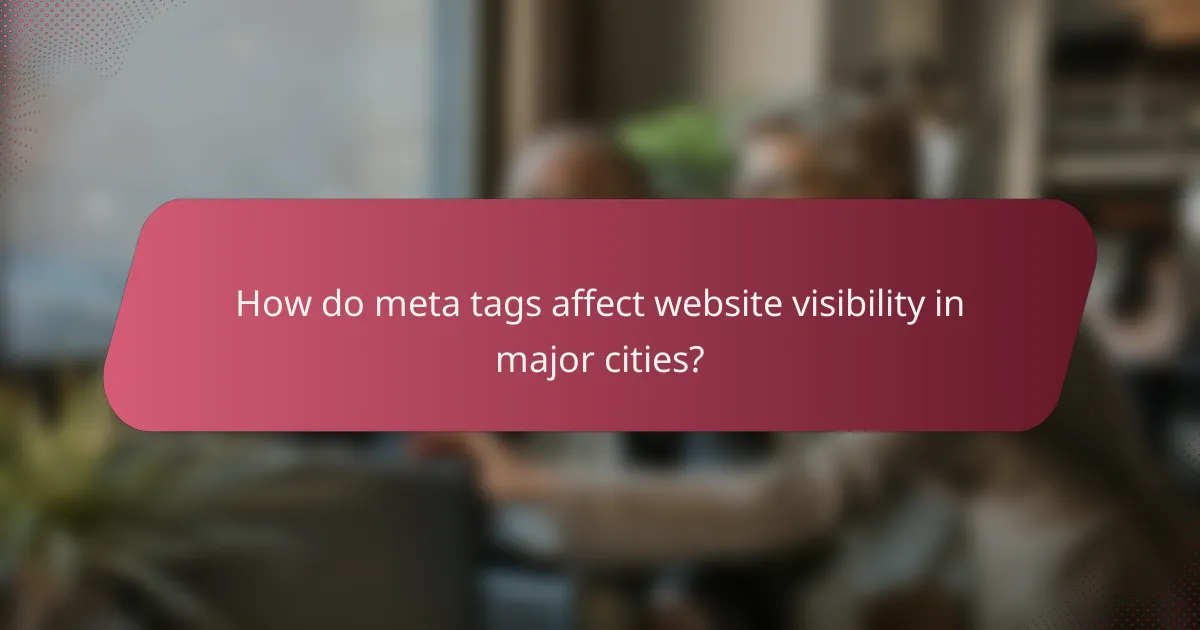
How do meta tags affect website visibility in major cities?
Meta tags play a crucial role in determining website visibility, especially in major cities where competition is fierce. They help search engines understand the content of a page, influencing rankings and click-through rates in localized search results.
Localized content strategies
Implementing localized content strategies involves tailoring your website’s meta tags to reflect the specific needs and interests of users in different cities. This can include using local keywords, city names, and cultural references that resonate with the target audience.
For example, a restaurant in New York might use meta tags that highlight local cuisine or popular neighborhoods, while a service provider in Los Angeles could focus on outdoor activities and attractions. This not only improves relevance but can also enhance user engagement.
Geo-targeted meta descriptions
Geo-targeted meta descriptions are essential for attracting users from specific locations. These descriptions should include location-specific keywords and phrases that appeal directly to the local audience, increasing the likelihood of clicks from search results.
For instance, a travel agency targeting Chicago might use a meta description like “Explore the best of Chicago’s skyline tours and local attractions.” This approach helps search engines deliver more relevant results to users searching in that area, improving visibility and performance.
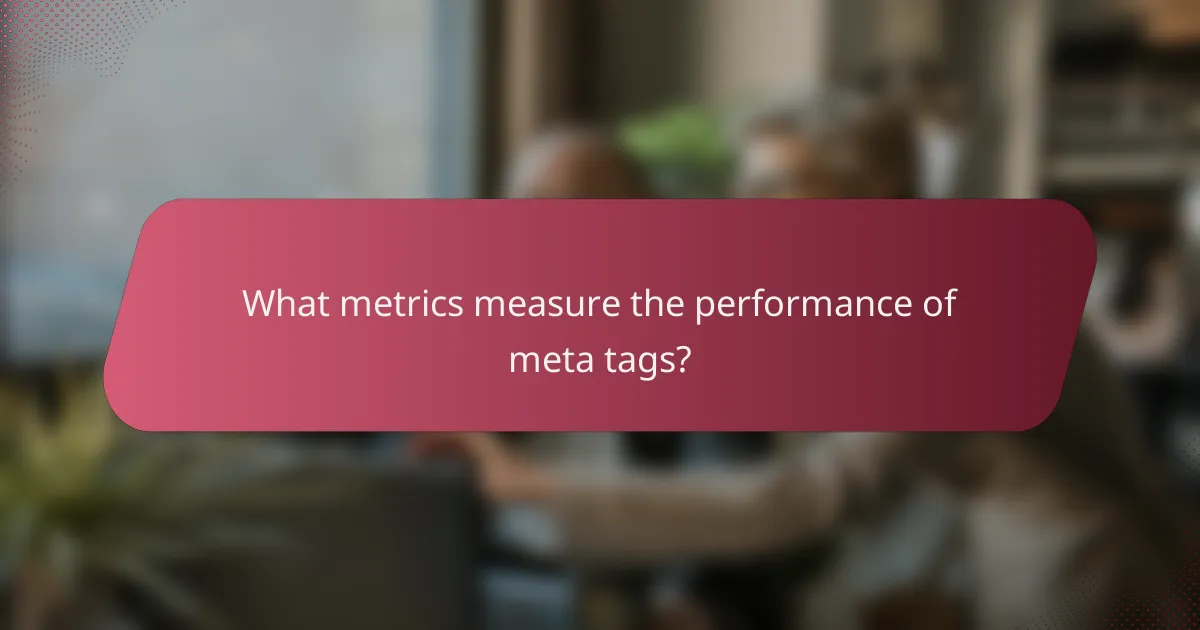
What metrics measure the performance of meta tags?
The performance of meta tags can be measured through several key metrics that indicate their effectiveness in driving user engagement and search engine visibility. The most significant metrics include click-through rate (CTR), organic traffic growth, and bounce rate analysis, each providing insights into how well meta tags are functioning.
Click-through rate (CTR)
Click-through rate (CTR) measures the percentage of users who click on a search result after seeing the meta title and description. A higher CTR indicates that the meta tags are compelling and relevant to users’ search queries. Aim for a CTR above 2-3% for optimal performance in competitive niches.
To improve CTR, ensure that your meta titles are concise, include relevant keywords, and create enticing descriptions that encourage clicks. Avoid using generic phrases; instead, focus on unique selling points or questions that resonate with your target audience.
Organic traffic growth
Organic traffic growth refers to the increase in visitors coming to your website from search engines as a result of effective meta tag optimization. Tracking this metric helps assess the overall impact of your meta tags on search visibility. A steady growth rate of organic traffic, typically in the range of 10-30% over several months, suggests that your meta tags are working well.
To enhance organic traffic, regularly update your meta tags based on keyword research and competitor analysis. Monitor changes in traffic patterns after adjustments to ensure that your optimizations yield positive results.
Bounce rate analysis
Bounce rate analysis involves examining the percentage of visitors who leave your site after viewing only one page. A high bounce rate may indicate that your meta tags are misleading or that the content does not meet user expectations. Ideally, aim for a bounce rate below 40% to indicate effective engagement.
To reduce bounce rates, ensure that your meta descriptions accurately reflect the content of your pages. Providing clear and relevant information in your meta tags can help set appropriate expectations, leading to lower bounce rates and improved user retention.
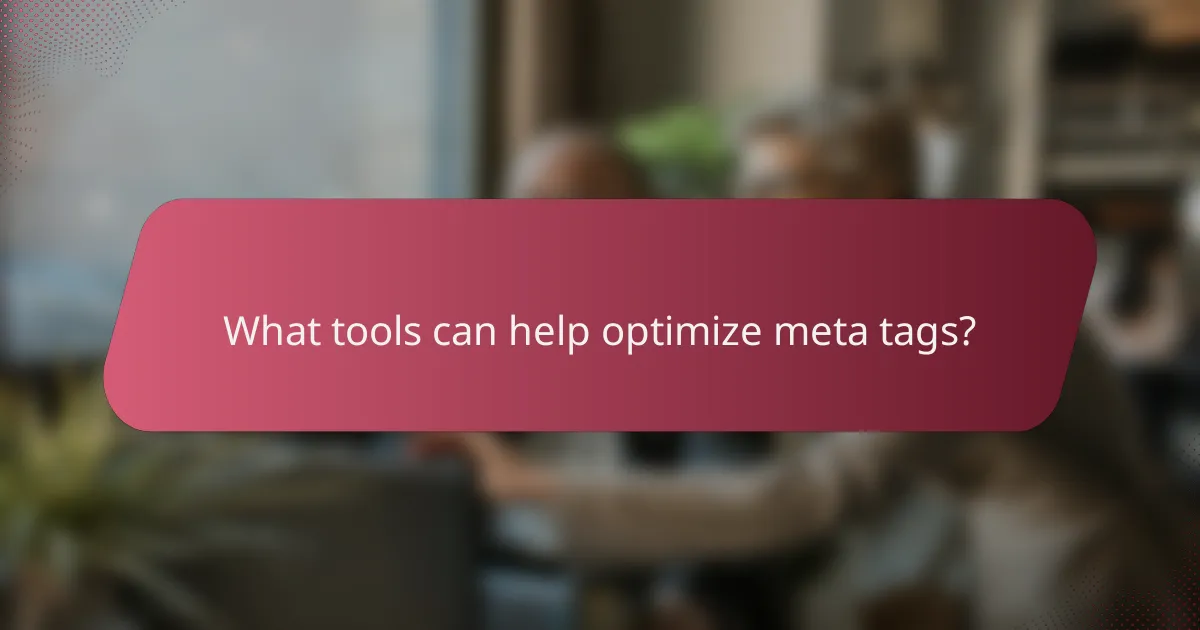
What tools can help optimize meta tags?
Several tools can effectively optimize meta tags, enhancing SEO and improving website visibility. Utilizing these tools can streamline the process of keyword analysis and ensure that meta tags align with best practices.
SEMrush for keyword analysis
SEMrush is a powerful tool for conducting keyword analysis, which is essential for optimizing meta tags. It allows users to identify high-performing keywords and phrases relevant to their content, helping to craft effective title tags and meta descriptions.
To use SEMrush effectively, start by entering your website URL or a competitor’s URL. The tool will provide insights into keyword rankings, search volume, and competitive density. Aim for keywords with a good balance of search volume and competition to enhance your chances of ranking well.
Yoast SEO for WordPress
Yoast SEO is a popular plugin for WordPress that simplifies the optimization of meta tags directly within the content management system. It provides real-time feedback on your meta titles and descriptions, ensuring they meet SEO standards.
When using Yoast, focus on the suggestions it provides for improving readability and keyword usage. The plugin also offers a snippet preview, allowing you to see how your meta tags will appear in search results. Regularly update your meta tags based on performance metrics to keep them relevant and effective.
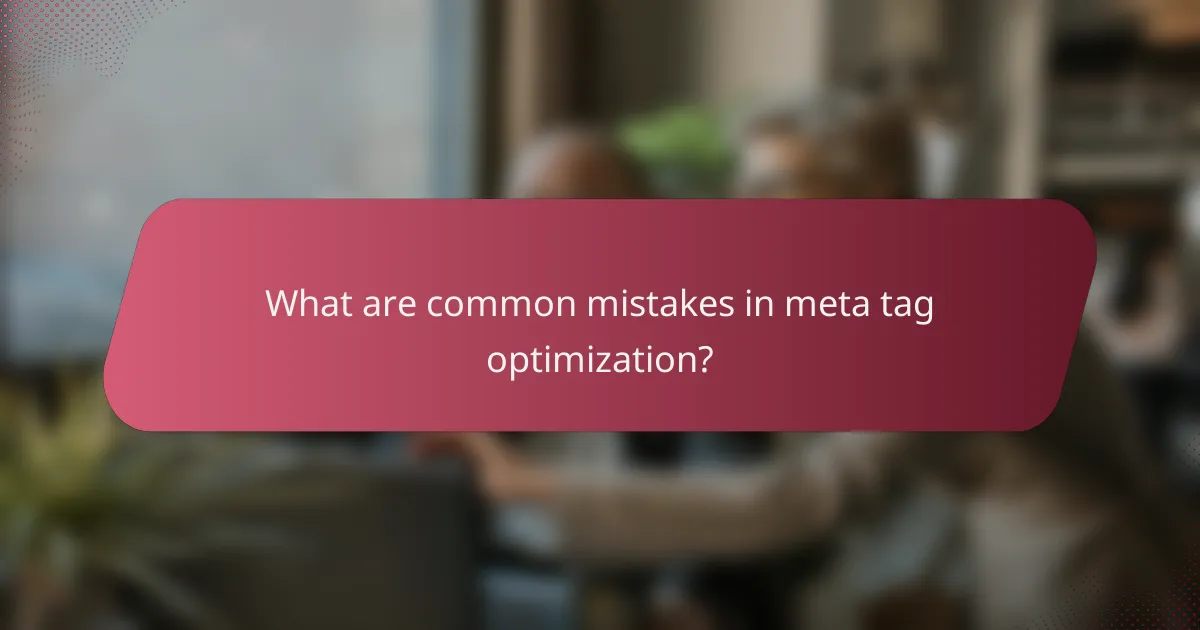
What are common mistakes in meta tag optimization?
Common mistakes in meta tag optimization include overstuffing keywords, neglecting to update tags, and failing to tailor tags for specific pages. These errors can hinder search engine rankings and user engagement.
Overstuffing keywords
Overstuffing keywords in meta tags occurs when too many keywords are crammed into a single tag, which can lead to penalties from search engines. Instead of improving visibility, this practice often results in lower rankings and a poor user experience.
To optimize effectively, focus on using one or two primary keywords that accurately reflect the content of the page. Aim for a natural flow in your meta descriptions and titles, keeping them concise—generally under 160 characters for descriptions and 60 for titles.
Common pitfalls include using irrelevant keywords or duplicating tags across multiple pages. Regularly review and update your meta tags to ensure they remain relevant and aligned with current content and search trends.
